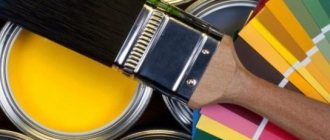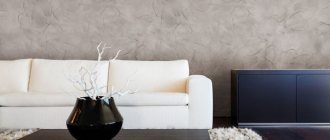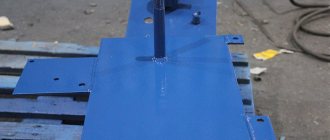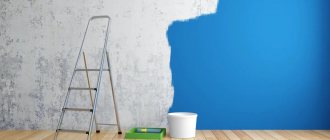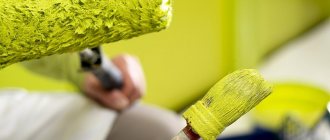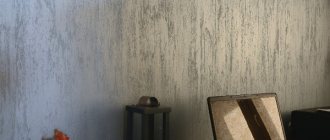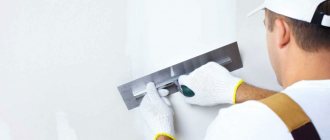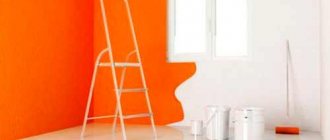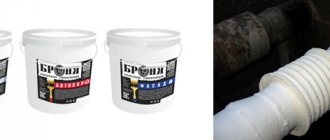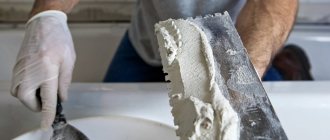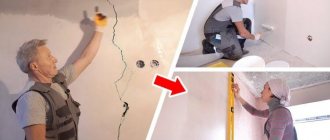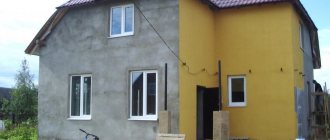Man is created in such a way that he gets bored with monotony. Often you want something new in life, in work and in the interior of your home. Often, in order to update their apartment or house, they resort to simple material that has been known for a very long time. What is it about? About regular paint. It is often used to treat walls. At the same time, the result is always surprising, since when done correctly, it all looks very beautiful. You just have to buy quality material. But here your eyes may run wild: there are so many types, so many colors, so many textures that it can be very difficult to choose.
How to figure it all out? We invite you to consider information about what types of wall paints exist and how to distinguish between them in order to choose the right option for yourself?
How to classify material
At first glance, you may think that buying wall paint will not be difficult. What's so complicated about that? But it is not so. There are many variations of paints, so some of them may not suit you. All materials differ in price, quality and characteristics. How can you separate colors? Let's consider:
These are the main criteria by which material can be distinguished. But that's not all. Wall paints may vary in composition. We will look at different compositions, their features and areas of application.
Differences in composition
In production, by adding certain components, the product is turned into something special. It has its own characteristics, advantages and disadvantages. What types of paints are there?
Water emulsion
Water-based or, as correctly, water-dispersion paint. The solvent in the material is water. That is why the mixture dries quite quickly and has no foreign odors. Water-based paint varies depending on the polymer that acts as a binder. It can be latex, acrylic resin or polyvinyl acetate. The last option is the cheapest; this paint is used to treat ceilings in dry rooms. The advantages of the paint are its vapor permeability, quick drying and lack of odor. In addition, it is easy to remove dirt from it.
Water-dispersed material can be divided into the following subtypes:
Oil formulations
As the name implies, they are made from oils, namely natural or synthetic drying oil. Various pigments are added to the composition, which dissolve in this oil.
The advantage of the material is that it is quite durable and strong. The composition can be used for internal and external work. However, it also has its drawbacks: it takes a long time to dry, it doesn’t allow air to pass through, and it doesn’t smell particularly pleasant. This is why such paint for walls in apartments is no longer used.
Alkyd material
The binder in the material is alkyd resin. It takes a little time for the composition to dry, since it dries due to the oxidation of the solvent upon contact with air. The surface is covered with a vapor-proof durable film. The smell from it is very pungent and unpleasant, so the use of the material in a residential area is quite rare.
Marker paint
Material based on epoxy resin, acrylic or polyurethane polymer. Once it dries, it creates a whiteboard effect. The composition is easily applied to a wall with a smooth surface, after which it hardens, creating a marker coating. The amazing thing is that you can write or draw on such walls with an erasable marker. After all the art, the marker is simply erased, leaving no marks on the wall. This is an ideal option for those who have small children. They love to paint on the walls, and with marker paint you don't have to do any renovations.
Note! The composition can be used to cover not only walls, but also furniture and interior items.
Composition of paint for interior wall decoration
The modern building materials market offers a wide selection of paints for decorating walls, which differ in chemical composition and active components. Let's look at the main types of paints and figure out which ones are suitable for indoor use.
- Oil formulations
This type of finishing material occupies a niche with a low price category and has a short service life. The coloring composition includes mineral and vegetable oils. After the paint is applied to the surface, it oxidizes, forming a film. Such a film becomes an obstacle to air circulation.
The layer of oil paint that covers the walls is short-lived, cracks quickly, and is unstable to mechanical stress. When decorating walls with such material, the result will not be of high quality.
- Alkyd paints
The consistency of the alkyd composition is very similar to oil mixtures. Alkyd paint contains vegetable oils (soybean, linseed), acidic and organic substances, which significantly increase the wear resistance of the material. The painted surface is highly durable and rich in color.
The Tikkurila and Element trademarks offer consumers alkyd enamel paints that are highly plastic when dry. The painted surface is resistant to moisture, temperature fluctuations and exposure to sunlight.
Alkyd compositions can be used to decorate walls, but they have a number of features, due to which use in residential premises is not recommended by experts. Alkyd paints have a strong specific odor, are highly flammable and have low vapor permeability.
Such decorative paints for interior wall decoration have excellent physical and chemical properties, but they can rarely be found on the shelves of hardware stores. The coloring composition includes liquid glass, which provides the painted surface with maximum mechanical strength. A layer of silicate paint mixture applied to the wall is resistant to moisture, fungi and mold, and also has excellent breathability, without the need to apply an additional protective layer.
Despite all the positive qualities of the silicate paint mixture, there are also a number of disadvantages. Ready-to-use coloring compositions contain a high percentage of alkalis, which is unsafe for human skin and mucous membranes. When carrying out painting work, it is necessary to use personal protective equipment. It should be noted that after the applied layer has completely dried, it becomes completely safe for humans.
Recommended articles on this topic:
Also, when tinting silicate mixtures, it is necessary to use alkali-based pigments, which eliminates the possibility of carrying out this procedure yourself, and most often there is a small range of colors on sale.
The silicate composition fits perfectly on mineral surfaces. You can successfully use such brick paints for interior decoration. But if the surface was previously painted with an organic compound, then before applying silicate paint it must be cleaned off, otherwise the new layer will not stick. You also need to keep in mind that the silicate mixture will not adhere to metal and polymers.
It should be noted that it will not be possible to apply another coloring composition to a surface that was previously painted with silicate paint. If there is a need to renew the coating, then you need to use silicate paints again or clean off the previously applied layer.
- Water soluble
One of the large groups of finishing materials most suitable for decorating walls. The common feature of this group is that they are all water based. Water contains all the important components - binding particles that help create a dense layer.
The composition of water-soluble mixtures includes pigments, various additives and fillers, which determine the main characteristics of the material.
In this case, it is acrylic resins that are the basis of coloring mixtures. Such compositions have a number of positive qualities: high elasticity, resistance to mechanical damage, moisture and sunlight. The high price of these paints for interior decoration is their only drawback.
Acrylic paint for interior decoration of walls made from OSB panels is very popular among consumers in Moscow, and the right color will make the interior unique.
- Latex
These paint compositions contain latex, which gives the painted surface moisture-resistant properties. Latex paint dries quickly, this coating is perfect for painting textured wallpaper and mineral surfaces. The painted layer is easy to clean and resistant to mechanical damage.
Latex paint for interior decoration is one of the best options for wall decor; it allows you to hide minor defects in the surface being painted. A rich color palette will satisfy the requirements of any designer.
- Water-based
Such paints for interior decoration are easily applied to the surface, hiding its cracks and defects, and dry quickly. On the finishing materials market, water-based paints are presented in a wide variety of colors and shades. The disadvantage of such paint mixtures for walls is their short service life. The layer of material is not resistant to moisture and is easily washed off.
- Water-dispersed
These are moisture-resistant compositions for interior wall decoration. Such mixtures fit perfectly onto the surface and have moisture-resistant and vapor-permeable properties. The painted surface is resistant to mechanical damage and low temperatures. Such decorative paints for interior wall decoration are available for sale only in two colors - white and black; other colors and shades can be obtained using tints.
Water-dispersed mixtures are suitable for painting wooden, concrete, and brick surfaces. Such compositions lie smoothly, do not flow or crack. The paints contain no solvents, which makes them safe for humans and the environment.
- Butadiene-styrene
Such mixtures are quite rare on the shelves of construction stores, and experts do not recommend using them for interior wall decoration. Despite the positive qualities of these coloring compositions, such as moisture resistance and resistance to mechanical stress, they have one significant drawback - photophobia. The painted surface quickly fades and loses its color when exposed to direct sunlight.
The concept of “decorative paint” for walls
Let's talk a little more about this species. Texture paint for walls appeared on the market not so long ago, but has already managed to gain its respect. Thanks to it you can achieve different design styles. Any texture can be imitated on the wall: silk, velvet, stone, silver, gold, etc. These techniques are used in designer rooms. Texture paint for walls is partly referred to as textured.
Note! There are products that change their color depending on the lighting in the room.
Decorative compositions can be classified as water-dispersive. Due to polymer or mineral substances, the composition changes and the desired effect is achieved. The material has many advantages: wear resistance, durability, safety for the body. In addition, the coating will not become covered with dust. This is an ideal option for decorating walls in an apartment.
Textured wall paint is applied in a special way, using special techniques and tools. These can be textured rollers, metal and plastic spatulas, as well as paint brushes of different sizes. There are many technologies for applying structural paint to walls. The result always surprises the owners.
The best silicone compounds
Paint with silicone resins appeared on the construction market not so long ago, but has already gained popularity due to its unique characteristics. These are universal compositions for interior and exterior wall decoration, resistant to mechanical stress, sunlight, and atmospheric conditions. The coating has heat resistance and antiseptic properties. The main disadvantage is the cost. It is higher than other types of interior paint. Most often you can find acrylic paint containing silicone on sale.
Paint "Caparol" "CapaSilan"
This durable matte paint does not contain solvents. The main advantage of this paint is that when applied even in a poorly lit room, a uniform monolithic coating is obtained on the wall without noticeable overlap of adjacent areas. The composition of the paint meets current sanitary standards. The coating is suitable for porous substrates and has high hiding power. “Caparol” “CapaSilan” paint can be used in rooms with high requirements for environmental friendliness and hygiene of finishing materials.
pros
- easy to apply;
- there is a water-repellent effect;
- can be washed and used in rooms with high humidity.
- hiding power.
Minuses
- high price.
Paint "Euro Extra 20" from "TIKKURILA"
Paint from a recognized leader in Finnish-made paints and varnishes. This type of silicone paint has some of the advantages that only silicone paint can have: color purity, resistance to sunlight, water resistance. The paint is easy to apply, odorless, and the coating can be washed with standard detergents.
pros
- environmentally friendly composition;
- easy application;
- UV resistance;
- long service life of the coating;
- moisture resistance;
- no smell.
Minuses
- high price.
Paint "Litotherm Paint Sil" from "LITOKOL"
Reliable protection of the base from external influences, moisture and dirt, as well as resistance to UV, combined with an affordable cost, have made LITOKOL brand silicone paint a popular product with the characteristics of a Premium category material. One of the advantages is a wide range of shades. The downside is that a high-quality and durable decorative coating can only be obtained by using other products (plaster, putty, primer) together with this paint.
pros
- moisture-resistant coating that can be washed;
- large selection of shades;
- resistance to external influences.
Minuses
- compatible only with LITOKOL brand materials.
Magnetic wall paint
This type of material can be called no less new. We can say that these are innovative technologies, since thanks to paint with magnets, your photos, pictures or applications do not have to be nailed down, secured with buttons or tape. All this is already a thing of the past, since magnetic paint exists. After drying, the wall will turn into a magnetic board, because a magnet will be attracted to it.
The thing is that fashion dictates its own. Nowadays, decorative elements that hang on the wall are quite popular, especially photographs and pictures. Therefore, a material appears that can hold all this on the walls. And with magnetic paint, the task is simplified twice as much. The thing is that it contains iron particles. And as you know, a magnet attracts iron. The composition is applied to one or another area, which will be the place for decorative elements; this is a kind of refrigerator with magnets. The coating has gained popularity for use in cafes, offices, classrooms, kindergartens and schools, as well as at home. All you need to do is take a photo, drawing or picture and attach it with a magnet. It looks very nice.
Advantages of the material:
- No unpleasant odors.
- Ecological cleanliness. The use of magnetic paint is permitted in educational and medical institutions. No negative effects on people or animals.
- Fire safety.
- They have increased adhesion to any surface.
And what’s most surprising is that the composition has a unique property. It muffles electromagnetic radiation from the TV, computer and microwave oven.
Manufacturers
We saw that the range is really very large. But is it worth taking the first paint you come across? Not at all. It is worth paying attention to the manufacturer, since the quality depends on him. What kind of companies are these? For example, Finnish paint Tikkurila has long been known for its excellent products. It is ideal for walls.
And it’s also worth it, because the material shows good results on walls and ceilings. German companies are also good. But still, we are closer to the familiar “Sniezka”, from a domestic manufacturer. It is considered the best among Russian manufacturers. The price-quality ratio is excellent.
Coating vapor barrier from
offers a unique mastic "GizElast", which traditionally performs the functions of 100% waterproofing, as well as 100% vapor barrier, at affordable prices.
The composition is widely used in both industrial and private construction. In order to work with mastic, you do not need to have special professional skills. It is enough just to stir the one-component solution and cover the surface to be treated with it. The material is applied in one, or better yet, in two layers. Consumption is 1-2 kg per 1 m². The composition is suitable for application to flat surfaces - such as walls and ceilings, and for use in sealing seams and joints. This allows you to quickly and easily treat surfaces, making them completely vapor-tight. In order to achieve maximum effect from the work performed, when choosing materials, you should first of all pay attention to their quality. We offer only the highest quality products. GizElast mastic is always in stock. You can buy it and order delivery right here on the website, or by calling: +7 495 231-9661 Cost: The Technoprok company offers 2 alternative materials for vapor barrier of walls.
- emulsions and mastic compositions (made in Israel), known in Russia as liquid rubber.
- Eurovent roofing films (made in Germany), also known as roofing membranes.
Despite the fact that films are “under-roofing”, they are a traditional material for vapor barrier of walls
. Most builders know only this material and for many it is a revelation that vapor barrier of walls can be done with liquid or paste waterproofing materials.
Vapor barrier of walls with films
If someone prefers to do the vapor barrier of walls the old fashioned way or has the 2 limitations mentioned above, then the Technoprok company offers a wide selection of different diffusion films of the Eurovent brand.
Eurovent diffusion membranes with high vapor permeability are used as an under-roof covering for pitched insulated roofs, as well as for vapor barrier of walls
.
Eurovent vapor barrier films are products characterized by high mechanical strength, which is one of the key properties for high-quality vapor barrier.
High UV stability (4 months) does not limit the time it takes to complete the work before installing the roof. This is not so important for vapor barrier of walls from the inside, but is a significant factor when installing vapor barrier of walls from the outside or when installing roof vapor barrier.
The advantage of Eurovent brand products is, undoubtedly, their durability, confirmed by wear tests carried out in one of the leading laboratories in Germany, Institut für textile Bau und Umwelttechnik GmbH w Greven.
Testing products using simulated wear conditions is one of the requirements of the European standard EN13859-1. This standard applies to materials used as underlayment for pitched roofs.
The Technoprok company presents single-layer and multi-layer membranes and films of German origin, from which you can choose the optimal one for each task. Vapor barrier membranes are designed to protect not only the roof, but also the wall and floor from exposure to vapors, preventing the appearance of fungi, mold and rot in the wood.
Areas of application of vapor barrier LLC Technoprok
In addition to the vapor barrier of the walls
, liquid rubbers, both emulsions and mastics, are the most convenient and reliable materials when proper hydro- and vapor barrier of the floor is required. This is especially true for the first floor, located above the basement or in a wooden house or in a wet room (shower room, bathhouse, laundry room, swimming pool, etc.).
In order for the building to be dry and warm in any weather, it is necessary to carry out roofing work competently and efficiently, one of the conditions of which is the correctly carried out vapor barrier of the roof. The use of liquid rubber for flat roofing is also convenient because it allows you to quickly and efficiently install a vapor barrier layer over a large area.
In order for the vapor barrier of a house to be effective, protect the building from the penetration of moisture from the outside and protect the insulation from exposure to moist air, it is necessary to understand what steam, condensation and dew point are.
Technoprok company specialists will advise you on the use of vapor barriers and wind barriers. In addition, we have very affordable prices for the entire range. In our warehouse we always have liquid rubber and waterproofing mastics, geotextiles and drainage membranes - in short, everything that is necessary for installing a vapor barrier and.
Paint vapor barrier is, in fact, a special paint. But you shouldn’t expect any special attractiveness from her. The purpose of a vapor barrier is to prevent water from passing through, either in liquid or gaseous form.
For vapor barrier by painting, bitumen mastics are used, modified with various additives to bitumen: Kukersol varnish (a solution of shale tar in solvents), lingosulfanate, used as a plasticizer. The main purpose of these additives is to increase plasticity in the cold, but there are others: reducing flammability, increasing resistance to acids and alkalis, UV irradiation, etc. Chlorinated rubber is also used for the preparation of varnish, and polyvinyl chloride, for the same purposes, tar and gummastic mastics or emulsions.
Main types of facade paints
The production of paints for facades is not limited to any specific list, however, there are paints that perform best in terms of durability and other characteristics. We will talk about them further.
Vinyl paints
The photo shows white vinyl water-dispersion paint for the Finncolor facade. Vinyl or polyvinyl acetate paint was once very popular when arranging facades, but today it is almost completely replaced by its acrylic counterpart. Facade water-dispersion paint (as vinyl paint is also called) is diluted with ordinary water. The main advantage of such paints is their low price. But at the same time, they are not resistant to chemicals, are susceptible to mold, and are not resistant to mechanical damage. During the drying process, vinyl façade paints shrink quite significantly.
Acrylic and acrylic-silicone facade paints
Facade latex paint is a composite definition of various acrylic-based facade paints, the most popular at the moment. Their main component is acrylic organic resin.
Acrylic paints look bright on facades and last a long time. Such paints have low water absorption and therefore surfaces painted with them are less susceptible to contamination. The vapor permeability of acrylic paints is also not very high, but at the same time their color range includes quite intense and durable shades. Latex façade paints form airtight and elastic layers that are highly resistant to abrasion. A subtype of latex paints are acrylic-silicone solutions, which combine the advantages of both acrylic and silicone. Compared to vinyl, they have higher vapor permeability and slightly lower absorption capacity. Acrylic-silicone paints for facades based on organic solvents are very resistant to abrasion and can be self-cleaning.
Silicone paints
Tikkurila silicone-based facade black paint Facade silicone paints, which include silane, siloxane and organosilicon solutions, are hydrophobic - they do not allow rainwater to be absorbed and allow it to flow down the wall surface. Thanks to this, silicone facade paint increases the durability of the facade for a long time and is not prone to contamination. At the same time, the surface painted with such paint remains vapor-permeable, since its microporous structure allows the diffusion of water vapor from the walls. Facade silicone paint allows walls to breathe and is also characterized by excellent adhesion to the base.
Other types of facade paints
There are also other, less popular, but also actively used types of facade paints:
- Lime paints . They are sold both in the form of ready-to-use solutions and in the form of a paste to be diluted with an appropriate volume of water. They do not contain organic resins and have disinfecting properties, which prevents the appearance of fungus and mold. They are most often used for the restoration of facades lined with lime plaster. Available primarily in white pastel colors.
- Facade silicate paint (aka silicon) . The composition of such paints is quite simple, they are resistant to various atmospheric conditions, and are slightly susceptible to mold and mildew. As a result of a chemical reaction, silicate paints bond exceptionally firmly to the base. However, for the same reason, they are very difficult to remove if it is necessary to restore the facade.
- Silicate-ash or polysilicon paints for facades . They are an improved modification of silicate paints, which was achieved by adding silicone resins to their composition. This type of paint is easier to apply with your own hands, resistant to direct contact with moisture, and has high vapor permeability. They perform best when applied to dry, but not seasoned cement or cement-lime plaster.
- Cement facade paints . They are sold in the form of dry mixtures diluted with the required amount of water. White Portland cement with the addition of polymer additives serves as the binding part of such paints. Initially white cement paint can be painted, however, only in soft, pastel shades. It is vapor permeable, but also quite moisture-intensive.
Silicate paint for facades, Czech production
Properties of paint vapor barrier
All the materials that were just mentioned above are united by excellent hydrophobicity, primarily adhesion to water. They collect water in droplets on their surface, which roll off very easily. Moreover, not having any pores, they do not allow gases to pass through, including water vapor, which is also a gas.
According to the method of preparation, hot and cold mastics are distinguished. Hot ones are heated in boilers to a temperature of +120 ... +170°C, and cold ones are treated with solvents to reduce the viscosity to the required level. Gudrokam (gudrokam is a material obtained by oxidation of a mixture of bitumen and anthracene oil, has very high biological resistance) mastic should be heated only to 70 degrees, and for rubber-bitumen it is necessary to ensure a temperature of 200 and very good exhaust.
Vinyl chloride varnishes protect stone materials well from moisture penetration and form a very good vapor barrier in several layers (for example, XB-701 varnish). However, their temperature range is limited: -15 ... +40°C, so they are not suitable for external work in areas with cold climates.
What facade paint is needed for certain surfaces?
Before you buy facade paint, you need to select a composition that matches the specific material. After all, the same type of paint may be ideal for finishing wood and, at the same time, completely unsuitable for concrete.
Facade paint for wood
When choosing paint for wood, keep in mind that this material is highly flammable and prone to absorbing moisture and rotting. So for wooden houses you should buy facade paint with the highest indicators of water and fire resistance, as well as vapor permeability. This will allow the tree not to accumulate moisture and rot from the inside.
It is important to look for a paint material that has good adhesion to the wood. Acrylic facade paint Tikkurila Pesto or Tikkurila Teho has this property. With the right coating, the wood will “breathe” and the paint will not begin to peel.
The most suitable paint for exterior woodwork is acrylic. It has the best performance in terms of adhesion to a wooden surface. In addition, acrylic lays flat on the wood texture.
For exterior woodwork, you can buy tinted or transparent facade paint. Transparent compositions have a high percentage of vapor permeability. They do not overlap the wood pattern, so it is better to purchase such specimens for owners of facades made of valuable wood. But it is better to buy tinted facade paints for those who have a wooden facade with imperfections.
Facade paint for bricks
Since brick is able to remove salts accumulated in it over time, it is worth choosing paint for exterior work with the correct coloring properties. Otherwise, the façade of the building will change its color and take on an unsightly shade. In addition, moss grows well on brick, which is why paint with weak adhesion can peel off.
Note: it is recommended to paint the brick facade of a building several years after construction.
So, facade paints for exterior brick work should be:
- vapor permeable;
- resistant to mechanical damage;
- water-repellent;
- resistant to chemicals.
It is best to buy façade paint for bricks based on acrylic or silicate. These compounds adhere well to the surface and, at the same time, allow it to breathe. In addition, silicate and acrylic paints prevent salt release and color change.
Sand-lime brick must be painted with cement or silicate compounds. Literally all types of paint and varnish coatings are suitable for ceramic bricks.
In Krasnodar, facade paint can be purchased in the online store Valles.ru. A filter based on parameters will help you quickly select the composition for bricks.
Facade paint for foam block
Foam block products are porous. Therefore, paint for foam block facades must be water- and dust-repellent. Silicone facade paints correspond to these parameters.
Keep in mind that when working with silicone paint, it is very important to seal the seams of the facade. If this is not done, cold bridges will appear on the coating, along which the paint will begin to peel off.
Note: the silicone composition is also excellent for external plastering work. Facade paints with a silicone base can be applied to any type of plastered surface: concrete, brick, foam block.
Facade paint for concrete
For gray concrete, it is best to buy facade paint in a bright color or an ideal white shade.
Paints and varnishes for concrete should be:
- moisture resistant;
- insensitive to ultraviolet radiation;
- frost-resistant.
Any paint is suitable for exterior concrete work. When choosing, you just need to consider the following points:
- Water-based compositions weakly protect concrete from moisture. But the water will dry out quite quickly, since these are vapor-permeable compounds.
- Oil compositions do not allow steam to pass through, but they provide better protection against moisture. In addition, before painting, the wall requires careful preparation: applying a primer, allowing it to dry completely, etc.
For concrete work, manufacturers of paints and varnishes most often produce acrylic, rubber or silicone compounds.
Where to buy high-quality facade paint in Krasnodar?
So, when choosing façade paint, take into account the material of the surface to be painted. The same paint will manifest itself completely differently on different materials. What works on wood may not work on brick surfaces.
High-quality facade paints are produced by Tikkurilla, Dulux, Tex, Caparol. On the product can, as a rule, the composition and purpose are indicated according to the type of surface to be painted.
You can buy paint for exterior use in Krasnodar in the online store Valles.ru. We offer a large selection of paints and varnishes. To avoid getting lost in the assortment and speed up the search process, use the filter in the left corner of the page. The search option “Suitable for” will help you select paint based on the type of surface to be painted. Placing an order will not take much time. You can leave a request on the website or by phone: +7 (861) 241-08-80.
